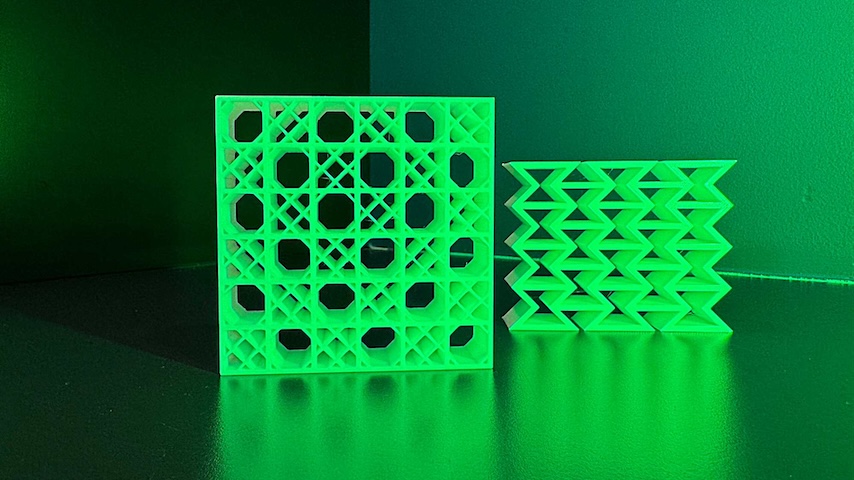Experiments Show Metals Gaining Strength When Heated
Experiments Show Metals Gaining Strength When Heated


Copper stronger than steel? When struck by tiny objects moving at high velocities, heated copper shows evidence of getting better able to resist impacts.
Researchers at the Massachusetts Institute of Technology (MIT) in Cambridge have demonstrated that when metal is struck by minuscule objects moving at high velocities, heating the metal makes it stronger. In fact, when subjected to higher temperatures, copper can actually be just as strong as steel.
This discovery could lead to exciting new ways to engineer metallic materials for extreme environments, such as shields that protect spacecraft or hypersonic aircraft or equipment for high-speed/high temperature manufacturing processes.
The common conception is that heating metals makes them weaker, especially as the temperature moves closer to the melting point of the material. After all, blacksmiths pound glowing red-hot iron to shape it, not cold ingots.
The research team, led by Christopher Schuh, former head of MIT’s Department of Materials Science and Engineering and now dean of engineering at Northwestern University, began with the goal of simply assessing the mechanical properties of metals at extreme strain rates and different temperatures.
 “It was a surprise when our first experiments at elevated temperatures showed that metals were getting stronger as compared to our testing at room temperature,” Schuh said. “This was not intuitive to us, and we spent time checking and rechecking it and devising new experiments to rule out possible artifacts.”
“It was a surprise when our first experiments at elevated temperatures showed that metals were getting stronger as compared to our testing at room temperature,” Schuh said. “This was not intuitive to us, and we spent time checking and rechecking it and devising new experiments to rule out possible artifacts.”
The ”aha” moment occurred when they found theoretical discussions in the materials mechanics literature suggesting that metals could indeed get stronger when heated, provided they were tested at extreme rates where the mechanism of phonon drag is dominant. This then became the focus of their metals research.
Extremely high-speed cameras were used “to watch the particles as they come in and as they fly away,” Schuh said. As the particles bounce off the metal surface, “the difference between the incoming and outgoing velocities tells you how much energy was deposited into the target—an indicator of surface strength.”
This data, noted Schuh, provides the first direct experimental evidence for this anomalous thermal effect of increased strength with greater heat.
“Methods of quantitatively measuring strength at these very high strain rates are still under active development,” Schuh said. “The ones we used are only a few years old. Beyond that, the method of microparticle impact testing had to be extended to high temperatures, and that line of work in turn required some inventions in our instrumentation. We are the first to use high temperature microparticle testing in a systematic way to explore the strength of metals.”
More Industrial Research: 8 New Materials with Game-Changing Properties
These research findings are counterintuitive and at odds with decades of studies in less extreme conditions. This metal-strengthening behavior will likely be used in finding new ways to design products for high-heat applications, such as high-speed machining operations and 3D printing processes used in manufacturing.
Schuh’s test results are a big step in better understanding how metals will behave in extreme strain rate conditions. There are many applications where metals are subjected to extreme strain rates, including hypersonic transport and cold-spray additive manufacturing.
“Our discovery provides an additional way to design and test materials for high-temperature applications,” he said.
The results were published in Nature in May 2024.
The effect may be felt in less extreme conditions, too, said Ian Dowding, an MIT graduate student who was part of the research team.
Meet 25 Early Career Innovators
“If you are flying a helicopter in a sandstorm, a lot of these sand particles will reach high velocities as they hit the blades,” Dowding said. “In desert conditions, temperatures could be hot enough to kick in the hardening effects.”
Now that the team has shown where this unique material behavior happens, “the next step is to see where it doesn’t,” Schuh said. “One clear boundary is the upper limit of temperatures a material can be tested to, the melting temperature. But what happens as we approach this temperature? How does the deformation mechanism change, if at all?”
Perhaps the most innovative aspect of Schuh’s work has been unlocking a field of mechanics “where we can test materials at extreme rates and low impact pressures, free of strong shock effects,” he said. “This has opened the door as a new way to test materials.”
Mark Crawford is a technology writer in Corrales, N.M.
This discovery could lead to exciting new ways to engineer metallic materials for extreme environments, such as shields that protect spacecraft or hypersonic aircraft or equipment for high-speed/high temperature manufacturing processes.
The common conception is that heating metals makes them weaker, especially as the temperature moves closer to the melting point of the material. After all, blacksmiths pound glowing red-hot iron to shape it, not cold ingots.
The research team, led by Christopher Schuh, former head of MIT’s Department of Materials Science and Engineering and now dean of engineering at Northwestern University, began with the goal of simply assessing the mechanical properties of metals at extreme strain rates and different temperatures.

Have You Renewed?
ASME membership confers many important professional and career benefits. Don't lose out — Renew your membership today!
The ”aha” moment occurred when they found theoretical discussions in the materials mechanics literature suggesting that metals could indeed get stronger when heated, provided they were tested at extreme rates where the mechanism of phonon drag is dominant. This then became the focus of their metals research.
Microballistic attacks
The team performed microballistic experiments using laser-induced particle impacts. They shot tiny particles of sapphire 10-20 microns in diameter at speeds of a few hundred meters per second at flat sheets of different metals (copper, titanium, and gold).Extremely high-speed cameras were used “to watch the particles as they come in and as they fly away,” Schuh said. As the particles bounce off the metal surface, “the difference between the incoming and outgoing velocities tells you how much energy was deposited into the target—an indicator of surface strength.”
This data, noted Schuh, provides the first direct experimental evidence for this anomalous thermal effect of increased strength with greater heat.
“Methods of quantitatively measuring strength at these very high strain rates are still under active development,” Schuh said. “The ones we used are only a few years old. Beyond that, the method of microparticle impact testing had to be extended to high temperatures, and that line of work in turn required some inventions in our instrumentation. We are the first to use high temperature microparticle testing in a systematic way to explore the strength of metals.”
More Industrial Research: 8 New Materials with Game-Changing Properties
These research findings are counterintuitive and at odds with decades of studies in less extreme conditions. This metal-strengthening behavior will likely be used in finding new ways to design products for high-heat applications, such as high-speed machining operations and 3D printing processes used in manufacturing.
Schuh’s test results are a big step in better understanding how metals will behave in extreme strain rate conditions. There are many applications where metals are subjected to extreme strain rates, including hypersonic transport and cold-spray additive manufacturing.
“Our discovery provides an additional way to design and test materials for high-temperature applications,” he said.
The results were published in Nature in May 2024.
The effect may be felt in less extreme conditions, too, said Ian Dowding, an MIT graduate student who was part of the research team.
Meet 25 Early Career Innovators
“If you are flying a helicopter in a sandstorm, a lot of these sand particles will reach high velocities as they hit the blades,” Dowding said. “In desert conditions, temperatures could be hot enough to kick in the hardening effects.”
Now that the team has shown where this unique material behavior happens, “the next step is to see where it doesn’t,” Schuh said. “One clear boundary is the upper limit of temperatures a material can be tested to, the melting temperature. But what happens as we approach this temperature? How does the deformation mechanism change, if at all?”
Perhaps the most innovative aspect of Schuh’s work has been unlocking a field of mechanics “where we can test materials at extreme rates and low impact pressures, free of strong shock effects,” he said. “This has opened the door as a new way to test materials.”
Mark Crawford is a technology writer in Corrales, N.M.






